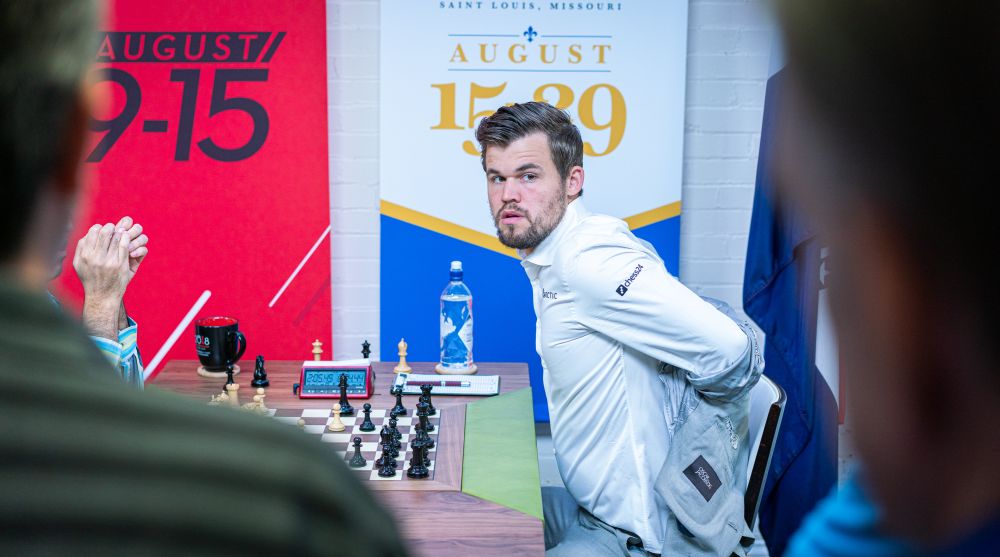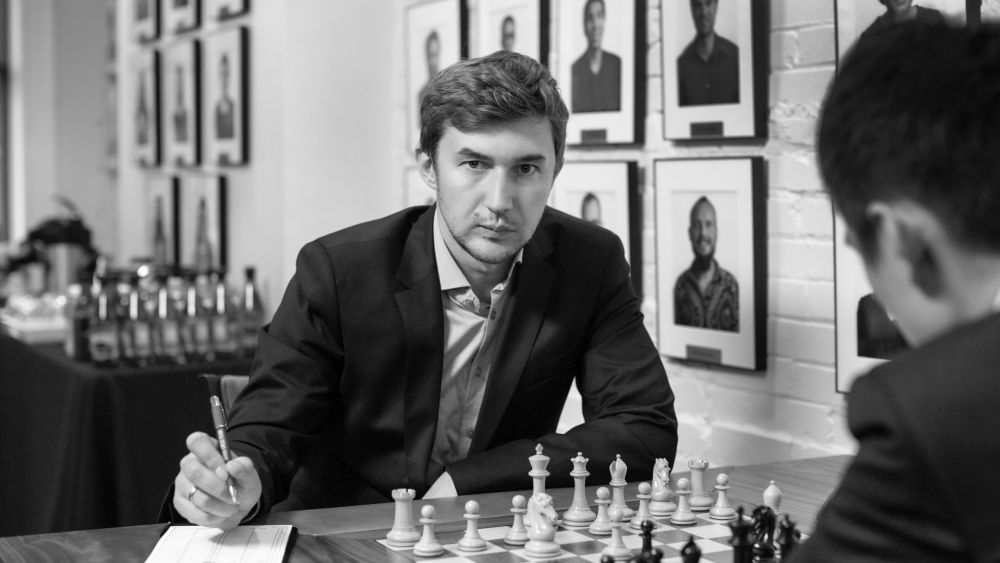


The first DVD with videos from Anand's chess career reflects the very beginning of that career and goes as far as 1999.
What promised to be a spectacle of bloodbath turned into a let down in the second round of the Sinquefield Cup in Saint Louis. About half an hour into the round, commentator Grandmaster Maurice Ashley proclaimed in his inimitable way, “there is a sizzle today!” aptly capturing the mood in all the games at that point. Indeed, they evoked lots of interest.
The biggest attraction of the round was the game between the pair who fought two world championship matches between them — Anand and Carlsen. Carlsen arrived a couple of minutes late for the game, as Anand sat sipping his tea. Once they started playing, it was obvious that this was a day when both of them were going to play a full-fledged battle. The game featured intriguing opening choices aimed at surprising each other, and had just entered a complex phase.
The Sicilian Rossolimo for White
The Rossolimo Variation 3.Bb5 is considered to be one of the strongest replies to 2…Nc6 in the Sicilian Defence. The fact that the move has been played by practically all the top players proves its popularity and strength. But the most interesting aspect of playing 3.Bb5 is that we force sharp, attacking players who love to have the initiative to forget about the Open Sicilian and to adjust themselves to a new world, one full of positional ideas, manoeuvres and nuances.
Isn't the Rossolimo Attack supposed to keep the position closed? What was Anand's intention in opening up the position with d2-d4, after playing the Rossolimo?! (Not to mention giving up the Bishop early in the game for the Knight!)
Anand explained after the game:
This morning, I was telling my second, 'We should check all the sidelines in the Rossolimo'. I said 4...bxc6 is a possibility, though (Carlsen) had never played before — he had always been taking (on c6) with the d-pawn...And then I got absorbed in all the other things I had to check, and I forgot to check this! (Now) I (felt) slightly exposed (when he played 4...bxc6 on the board) because he is targeting my game with Shakh (Mamedyarov) from Norway (2019) and Boris (Gelfand) in Amsterdam (2019). I had not really revised (that variation), so the question is should I go in for something and basically ask him what he prepared today morning?! And then I realised that there is this idea 5.d4, which is quite interesting, (following) with taking on c5 and continuing with a2-a3 and b2-b4.

Vishy Anand — opening intricacies | Photo: Lennart Ootes / Grand Chess Tour
This was the position Anand was discussing from his earlier games with Mamedyarov and Gelfand continuing with 5.0-0 ♝g7 6.♖e1 here. That explains why he had gone for the unusual continuation of 5.d4 in spite of having given up his bishop already, and confidently violating the middlegame principle we all learn at school: do not open the position when you have knights and your opponent has the bishops, and do not close the position when you have bishops and your opponent has knights!
But Carlsen continued calmly, and left the spectators puzzled with an unorthodox plan.
Carlsen's 9...f6 was intriguing, to say the least — count for yourself the number of positional principles thus violated! However, Carlsen had one more shock (though a pleasant one) for the spectators — he went into the confession booth and acknowledged that he was delaying castling which was not really ideal, but expressed it in a jolly way,
I think the general rules for opening play is that if you are one move away from castling you are pretty much always fine. If you are three moves away from castling, you are never fine, and if you are two moves away from castling, it could go either way! So, right now I am two moves from castling, let's see how it goes!
It also meant that he was in quite a relaxed mood, and wasn't really feeling any concern about his position.
Magnus Carlsen’s visit to the confession booth #SinquefieldCup pic.twitter.com/7U2636kZBE
— Grand Chess Tour (@GrandChessTour) August 18, 2019
Later, asked about the confession on the basics of castling quickly in the opening, if this was a rule they wrote in the Norwegian children's book or something?, a smiling Carlsen said, "I recently thought (it) up myself! But I think it makes perfect sense. That's the point".

Magnus Carlsen was in a relaxed mood | Photo: Lennart Ootes / Grand Chess Tour
Sergey Karjakin and Ding Liren were involved in a 'sharp' Marshall Attack game, and went deep into their preparation to enter a complex ending pretty early. We emphasize on the sharpness part of the opening because, at the highest levels of chess nowadays, due to deep opening preparations, even ultra-sharp openings have been analysed — and concluded to lead to drawn positions. Considering that, Karjakin's prepared novelty seemed to have caught Ding in some trouble.
Black Repertoire against 1.e4 Vol. 1: The Marshall Attack
The Marshall Attack is one of the most dynamic replies Black has at his disposal against 1.e4. At the cost of a pawn, Black takes over the initiative from the get - go and goes after the white king. Wrongly considered to be mainly a drawing weapon by some, this DVD offers many new ideas for Black, showing how to keep the queens on the board and to play for a win in almost all cases.
Karjakin's last move, 23.♖a5 seemed to be an improvement over So – Ding, from Candidates 2018 which had continued with 23.Qxf5. After Ding's 23...♛xf3 24.♘xf3 ♜e8?! (24...b4 looked better) 25.b4! Karjakin seemed to have taken over the initiative.

Sergey Karjakin with deep preparation | Photo: Lennart Ootes / Grand Chess Tour
Vachier-Lagrave had shown his aggression by playing quite sharp from the opening phases in the first round itself, and he continued with the same spirit in the second round too.
My Black Secrets in the Modern Italian
The Italian Game is considered a sound but quiet opening without early trades, giving rise to rich positions where plans are more important than forced variations. So shows black's plans on this DVD.

MVL in an ultra-aggressive mood | Photo: Justin Kellar / Grand Chess Tour
At this point, Magnus Carlsen stole the thunder, when he once again appeared in the Confession Booth, to talk about... MVL's position!
I forgot one thing last time (in the confession booth), which is to congratulate Maxime on playing some really classical positional chess, apart from the fact that he sacrificed a pawn. So, as a kid you are taught that the perfect setup for your pieces is Bishops on f4 & c4, Knights on c3 & f3, and then pawns on e4 & d4 because then you control the maximum amount of central squares. He already has a rook on e1, he just misses the rook on d1 for perfect positional harmony, at least the way we are taught as kids.
Now, we leave it to the reader to conclude whether this was out of a general sense of fun or trolling the Frenchman!
Magnus visits the confessional booth again, this time to give a shout out to Maxime! #SinquefieldCup pic.twitter.com/2BRIaSePNP
— Grand Chess Tour (@GrandChessTour) August 18, 2019
Anish Giri's Italian Game against Levon Aronian was another deep theoretical battle where the Armenian had a prepared improvement for the Dutchman in the opening phase.

Anish Giri in a theoretical battle against Aronian | Photo: Lennart Ootes / Grand Chess Tour
By this time, the other two games seemed to be developing as direct and open confrontations.
A typical position from a Najdorf where both sides were poised for a violent kingside attack. The most interesting place at this point was the Kingside Diner, the restaurant next to the tournament hall, where Grandmasters Alejandro Ramirez and Cristian Chirila have a live interactive commentary sessions with the audience. Everyone was treated to a violent attacks and bold sacrifices at this point, the position being ripe for tactical play.

Ramirez and Chirila enjoying at the players' expense | Photo: Lennart Ootes / Grand Chess Tour
But without doubt, the most inspired performance of the round came from Shakhriyar Mamedyarov, who showed original home preparation in a well-known position from the Queens Gambit, and initiated ambitious play from the start against Hikaru Nakamura.
Power Play 23: A Repertoire for black with the Queen's Gambit Declined
On this DVD Grandmaster Daniel King offers you a repertoire for Black with the QGD. The repertoire is demonstrated in 10 stem games, covering all White's major systems: 5 Bg5, 5 Bf4, and the Exchange Variation.
A very common position, existing since 1994, where 11.g4 has been the established mainline with its own twists and turns. Here, Mamedyarov unexpectedly came up with 11.♖g1!? immediately infusing life into the position. But more than anything, his opponent went into hilariously surprising contours.
Which emojis define Hikaru’s facial expressions? #SinquefieldCup pic.twitter.com/G2gCH4gzfF
— Grand Chess Tour (@GrandChessTour) August 18, 2019
Thus, when the Sunday crowd had eagerly settled down, further course of the games was disappointing for the expectation levels of the spectators.
The biggest drama was seen in the following game:
On pointing out that he missed this crucial 'shot', Nepomiachtchi — who turned up for the second round with a different and more common haircut than we saw on Saturday — admitted that he missed out the crucial idea 30...♛a7 after the sacrifice 28...♜xa3. “It hurts! I was calculating ♜xa3 literally each move — may be now ♜xa3 works? May be now? But the position was extremely unclear to calculate clearly”, said Nepomniachtchi after the game.
The Art of the Positional Exchange Sacrifice
The positional exchange sacrifice is one of the most powerful and fascinating strategic weapons in chess. On this DVD Sergey Tiviakov explains why the positional exchange sacrifice is such a strong weapon and how to use it.

Ian Nepomniachtchi on missing a sacrifice | Photo: Lennart Ootes / Grand Chess Tour
Thus, all the games deceiving the disappointed spectators, only Giri soldiered on after winning a pawn against Aronian, but couldn't make any headway.
GM Daniel King covers the highlights of the second round